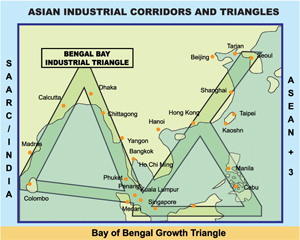
The Bay of Bengal Growth Triangle and Bangladesh-Japan strategic partnership
Salahuddin Kasem Khan | Monday, 25 August 2014

The joint Japan-Bangladesh Public-Private Economic Dialogue, held last week in Dhaka, was an important event. It took place about two weeks ahead of the forthcoming visit of Mr. Shinzo Abe, the Prime Minister (PM) of Japan, to Bangladesh. Abe will be accompanied by some of the top corporate leaders of Japan and lead a large delegation representing both the government and private sectors.
This writer was in Tokyo last month and met some representatives of businesses there. They showed great interest in Bangladesh as a new investment destination. It is relevant to note that the outward investment flow from Japan to China, according to the news agency AFP, crashed 45.4 per cent in the first seven months of this year to US$2.83 billion.
We need to satisfy Japanese companies' requirement for land, energy, regulatory support and skilled workforce. We are encouraged that the government has recently set up a high-powered inter-ministerial joint committee to address the outstanding issues and a Senior Secretary of the Prime Minister's Office (PMO) is overseeing the process.
During the visit of Prime Minister Sheikh Hasina to Japan earlier this year, Prime Minister Abe broached the idea of a Bay of Bengal Growth Triangle. This has drawn the attention of all in the region. Indeed, Bangladesh, being at the apex of the Bay of Bengal with India and South Asian Association for Regional Cooperation (SAARC) to the West, China to the North and Association of South East Asian Nations (ASEAN) +3 to the East, could emerge as a Mega Asian Growth Triangle, attracting trade and investment from this region, particularly from Japan.
Being in a unique position for regional connectivity, Bangladesh would in the future connect Kunming, China through Myanmar in Cox's Bazaar. Growth Triangles have produced the newly industrialised countries (NICs) like Thailand, Malaysia, Singapore, Indonesia and Vietnam. This has triggered their economic breakthrough with Japanese investment, trade and technology.
This writer has been drawing the attention of policy-makers both in Bangladesh and Japan to the report of the Japanese International Cooperation Agency (JICA), prepared in 1995 for the Board of Investment (BoI). Bangladesh, according to this report, "should, at any rate, win her reasonable share of this flow of FDI. Bangladesh, as a late-comer to this fiercely competitive environment, should make strenuous efforts with creative and innovative concepts and approaches to lessen the gaps with fore-running neighbouring industrial economies. To focus intensive development efforts on a priority basis, even if this should imply temporary regional disparities."
An industrial development policy would involve a "trade-off" between "intensive investment" which pursues investment efficiency, and "equitable investment" which seeks regional balance over the country. According to this strategic approach, it is recommended to designate the priority regions as "Special industrial Development Regions (SIDR)" (or what we call special economic zones or SEZs) to which resources should be allocated on a priority basis. Apart from the mobilisation of priority resources, various institutional incentives should be given to the SIDRs so that they can attract more FDI and promptly grow to the internationally acknowledged "Designated Economic Regions" or SEZs.
In Bangladesh, the following four regions would have the potential to be designated as SEZs: Dhaka Region, Chittagong Region, Sylhet Region and Khulna Region.
Industrial development in Chittagong is of national importance and significance, implying not merely developing the regional industrial base but building the national industrial base for the benefit of the whole country and the region surrounded by the Bay of Bengal as well.
This writer believes that the government's proactive strategy on SEZs in various parts of the country, supported by JICA and other development partners, should follow the areas, identified by the afore-mentioned JICA report. The report needs to be updated since it was prepared about two decades back. But its fundamental parameters are still valid.
Bangladesh remains far behind in information communication technology (ICT) and knowledge-based economy amongst South Asian and Pacific countries. This has been noted by the Asian Development Bank (ADB) in one of recent reports. Bangladesh is planning to set up a number of IT parks. Let us partner with Japanese information technology (IT) companies and these may be co-located with technical universities like Chittagong University of Engineering & Technology (CUET), Sylhet University of Engineering & Technology (SUET) and Rajshahi University of Engineering & Technology (RUET) which can provide skilled IT workforce. We need to graduate and shift from labour-intensive growth to productivity-led growth, from readymade garments (RMG) to ICT.
The private sector in Bangladesh believes that given the active support of government agencies like BoI, Bangladesh Economic Zone Authority (BEZA), Bangladesh Export Processing Zone Authority (BEPZA) and the Prime Minister's Office (PMO), along with JICA/JETRO/JIBC and other Japanese government agencies, a coordinated strategy needs to be in place so that we can ride the next wave of Japanese investment in South Asia after South East Asia. We expect that it will be initiated by the forthcoming historic visit of the Prime Minister of Japan to Bangladesh.
All of us, in the private sector, need to work together for a Japan-Bangladesh strategic partnership framework to realise the vision of the Bay of Bengal Growth Triangle, articulated by the Prime Minister of Japan during the visit of our Prime Minister to Japan this year. Bangladesh can then catapult itself to a Middle Income Country (MIC) by 2021 and a developed country soon afterwards.
This is an edited version of a presentation made by the writer who is vice-president of Japan-Bangladesh Chamber of Commerce & Industry or JBCCI at the joint Japan-Bangladesh Public-Private Economic Dialogue, held last week in Dhaka.